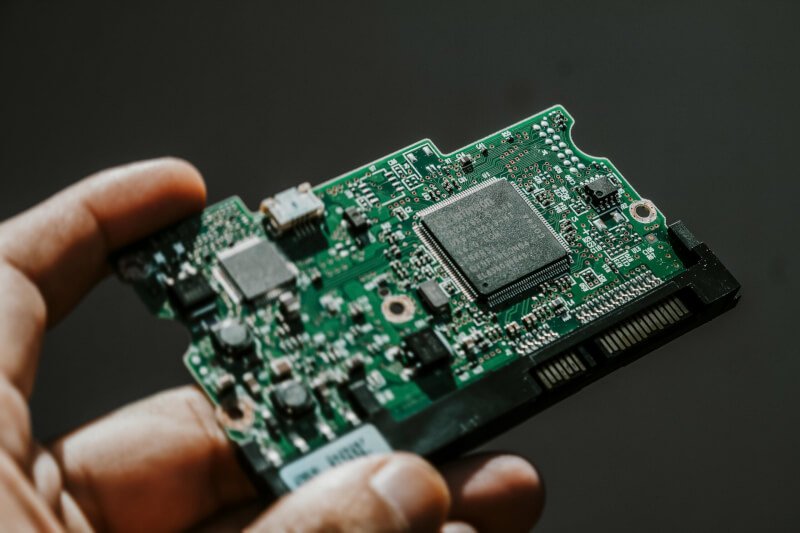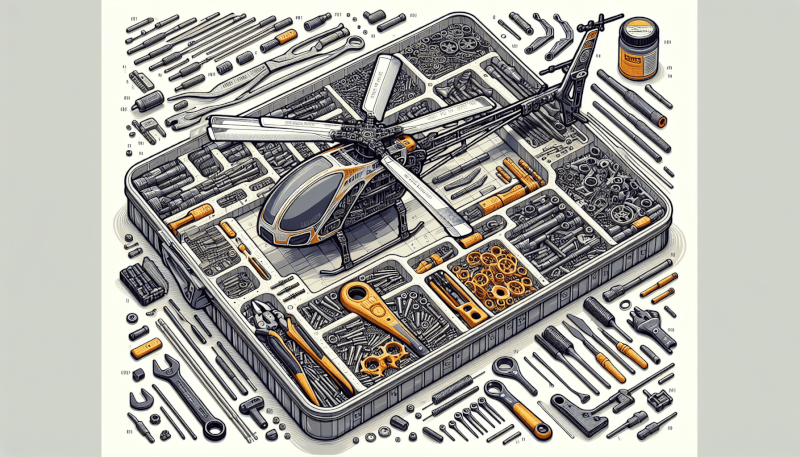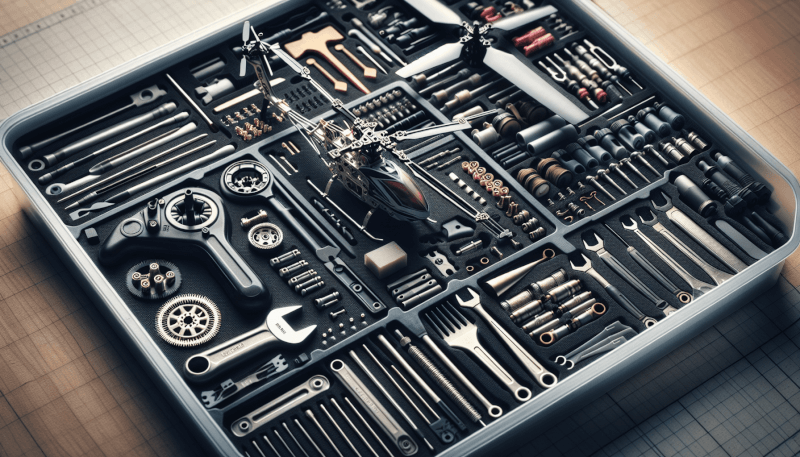When it comes to taking flight with your RC helicopter, the last thing you want is for it to come crashing down due to a minor mishap. That’s why it’s crucial to have the most essential spare parts on hand to ensure a smooth and uninterrupted flying experience. From extra main rotor blades to spare tail booms, having these key components readily available will not only save you from frustration but also keep your RC heli soaring through the skies for longer periods of time. So, let’s explore the must-have spare parts that every RC helicopter enthusiast should have in their toolbox.

Main Rotor Blades
When it comes to main rotor blades for your RC helicopter, there are a few different options to consider. One popular choice is composite blades. These blades are typically made from a combination of materials such as carbon fiber and fiberglass. They offer a good balance of strength and flexibility, making them a reliable choice for many pilots.
Another option for main rotor blades is carbon fiber blades. These blades are known for their exceptional strength-to-weight ratio, making them a popular choice among experienced pilots. Carbon fiber blades are lightweight yet incredibly durable, allowing for smooth and efficient flight.
For those who prefer a more traditional approach, wooden blades are also available. While they may not offer the same level of performance as composite or carbon fiber blades, wooden blades provide a classic look and feel. They can also be a cost-effective option for beginners or those on a budget.
Tail Rotor Blades
In addition to main rotor blades, the tail rotor blades on your RC helicopter are crucial for maintaining stability and control during flight. Plastic tail rotor blades are a common choice for many pilots. These blades are lightweight and affordable, making them a popular option for beginners.
For those looking for greater durability and performance, carbon fiber tail rotor blades are worth considering. These blades offer increased strength and rigidity, providing improved responsiveness and stability. Carbon fiber tail rotor blades are often used by experienced pilots who require precise control and maneuverability.
Main Gear
The main gear of your RC helicopter is responsible for transmitting power from the motor to the main rotor blades. There are two main types of main gears: metal and plastic. Metal main gears offer superior strength and durability, making them ideal for high-performance helicopters. However, they can be more expensive and may require more maintenance.
On the other hand, plastic main gears are lightweight and affordable. They are a common choice for beginners or those flying smaller helicopters. While not as durable as metal gears, plastic gears can still provide reliable performance for casual and intermediate pilots.
Tail Boom
The tail boom of your RC helicopter provides stability and keeps the tail rotor in the correct position. Carbon fiber tail booms are known for their strength and lightweight properties. They offer excellent rigidity and are resistant to bending or warping. Carbon fiber tail booms are commonly used in high-performance helicopters that require precise control and agility.
Alternatively, aluminum tail booms provide a balance of strength and affordability. They are durable and can withstand rough landings or crashes. Aluminum tail booms are often chosen by pilots who prioritize durability over weight savings.

Landing Skids
Landing skids play a crucial role in protecting your RC helicopter during takeoff and landing. Plastic landing skids are the most common option and can be found on many beginner and intermediate helicopters. They are lightweight, affordable, and offer good impact resistance.
For those requiring additional strength and durability, carbon fiber landing skids are a popular choice. These skids are lightweight yet incredibly strong, providing excellent protection for your helicopter. Carbon fiber landing skids are often favored by experienced pilots and those flying high-performance helicopters.
Metal landing skids are another option for those seeking maximum durability. While heavier than plastic or carbon fiber, metal landing skids are exceptionally strong and can withstand rough landings and impacts. They are commonly used in larger helicopters or for pilots who prioritize durability over weight savings.
Servo Motors
Servo motors are responsible for controlling the movement of various parts of your RC helicopter, such as the rotor blades and tail rotor. There are two main types of servo motors: digital and analog.
Digital servo motors offer precise control and fast response times. They use digital signals to accurately position the servo arm, resulting in precise movement and improved flight performance. Digital servo motors are commonly used in high-performance helicopters that require precise and rapid movements.
Analog servo motors, on the other hand, are a more affordable option. While they may not offer the same level of precision as digital servos, they still provide reliable performance for most applications. Analog servo motors are typically found in beginner and intermediate helicopters or for pilots on a budget.

Receiver
The receiver is the component that receives signals from your transmitter and translates them into commands for your RC helicopter. The number of channels a receiver has determines the number of functions it can control. There are typically three options to consider: 6-channel, 8-channel, and 12-channel receivers.
A 6-channel receiver is the most basic option and is suitable for simple helicopters with minimal functionality. It can control the main rotor, tail rotor, and a few other basic functions. This type of receiver is commonly used in beginner or intermediate helicopters.
For pilots looking to control more advanced functions, an 8-channel receiver is a good choice. It provides additional channels for controlling features such as landing gear, retractable systems, or complex flight maneuvers. An 8-channel receiver is commonly used in intermediate or advanced helicopters.
For those flying high-end helicopters or requiring precise control over multiple functions, a 12-channel receiver is the ideal choice. This receiver provides the most channels, allowing for full customization and control over all aspects of the helicopter. It is commonly used by experienced pilots or for advanced aerial photography and videography applications.
Electronic Speed Controller (ESC)
The electronic speed controller, or ESC, is responsible for controlling the speed and direction of the motor in your RC helicopter. There are two main types of ESCs: brushed and brushless.
Brushed ESCs are a more traditional option and are commonly found in beginner or intermediate helicopters. They are simple to operate, affordable, and can provide adequate performance for most applications. Brushed ESCs are typically used in smaller helicopters with lower power requirements.
On the other hand, brushless ESCs offer superior performance and efficiency. They are commonly used in high-performance helicopters that require maximum power and responsiveness. Brushless ESCs are more expensive but provide better control and longer flight times due to their efficient operation.

Battery
The battery is the power source for your RC helicopter and plays a crucial role in flight performance and duration. Two popular types of batteries are frequently used: LiPo (Lithium Polymer) and NiMH (Nickel-Metal Hydride).
LiPo batteries are the most common choice for high-performance helicopters. They offer high discharge rates, allowing for increased power output and improved flight performance. LiPo batteries are lightweight and compact, making them ideal for helicopters with limited space for battery installation.
NiMH batteries are a more affordable option and are commonly used in beginner or intermediate helicopters. While they may not offer the same level of performance as LiPo batteries, they are still capable of providing adequate power for most applications. NiMH batteries are heavier and larger than LiPo batteries, but they have a longer lifespan and require less maintenance.
Charger
To keep your RC helicopter batteries charged and ready for flight, a charger is essential. There are two main types of chargers available: balance chargers and fast chargers.
Balance chargers are designed to evenly charge the cells within LiPo batteries, ensuring they maintain optimal performance and lifespan. These chargers typically offer multiple charging ports, allowing you to charge several batteries simultaneously. Balance chargers are a popular choice for those flying high-performance helicopters with LiPo batteries.
Fast chargers, as the name suggests, are designed to charge your RC helicopter batteries quickly. They typically offer higher charging currents, allowing for rapid charging times. Fast chargers are commonly used by pilots who require quick turnaround times between flights or who have multiple batteries to charge.
In conclusion, when it comes to spare parts for your RC helicopter, it’s important to choose the right components to ensure optimal performance and durability. Consider factors such as your skill level, budget, and specific requirements to make the best choices for main rotor blades, tail rotor blades, main gear, tail boom, landing skids, servo motors, receiver, ESC, battery, and charger. By selecting the appropriate spare parts, you can enhance your flying experience and maximize the longevity of your RC helicopter.



